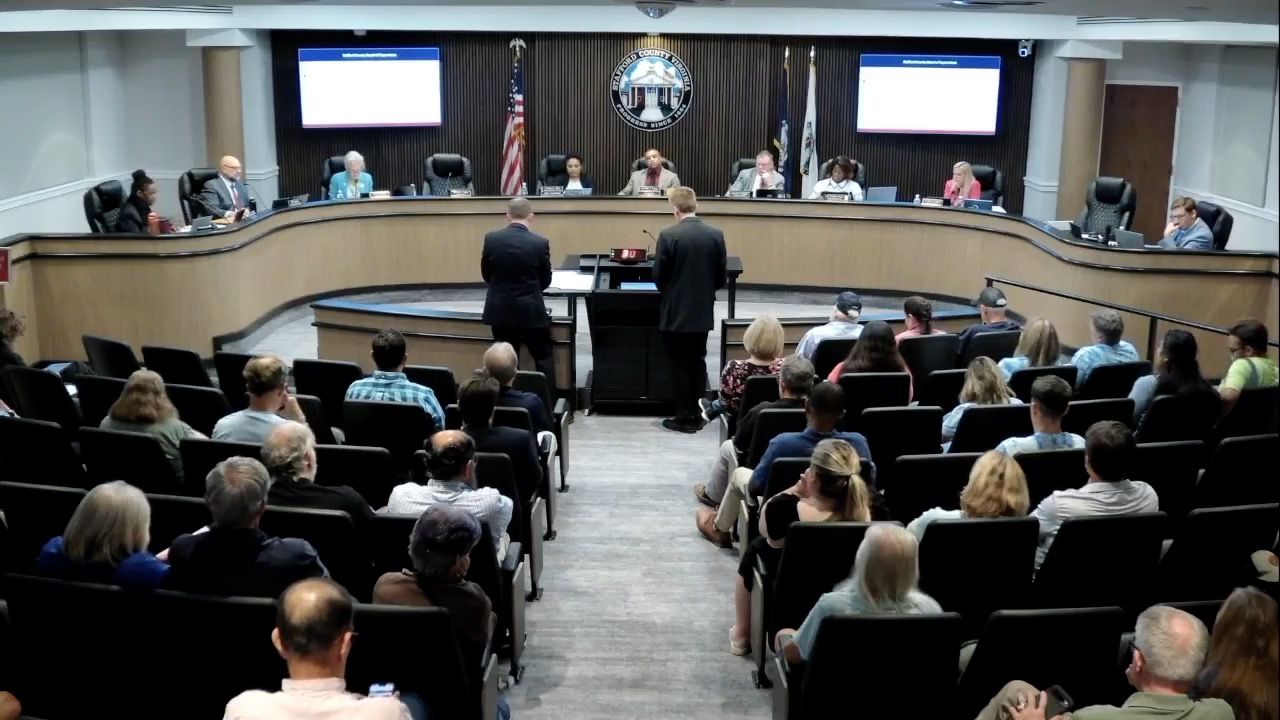
STAFFORD COUNTY — Stafford County leaders are weighing whether to impose stricter rules on data centers, as residents and advocacy groups warn the industry’s rapid expansion is already too close to neighborhoods, schools, and sensitive environmental areas.
On Tuesday, August 26, the Board of Supervisors held a meeting to review proposed updates to the county’s zoning ordinance and comprehensive plan. The changes come just two years after Stafford first adopted rules regulating the booming industry.
Background: From Incentives to Expansion
Virginia first incentivized data centers in 2008 with a sales and use tax exemption, fueling the industry’s concentration in Northern Virginia. In 2025, Gov. Glenn Youngkin vetoed bills that would have tightened local oversight, reaffirming a pro-growth stance that leaves regulation to counties.
Stafford first saw serious developer interest in 2022–23, leading to the county’s first wave of applications. In March 2023, supervisors and commissioners held a work session to learn about the facilities and their impacts. By October of that year, the Board adopted new rules that limited siting to the M-2 industrial district, required 100–200 foot setbacks, mandated vegetative buffers and open space, and included sound studies. Four early projects were grandfathered under previous rules.
2025 Review and Potential Tightening
This spring, supervisors ordered a new review amid mounting concerns. A Planning Commission subcommittee met five times in June and July, forwarding draft amendments in July. Among the proposals:
-
Location: Limit siting to within 0.5 miles of transmission corridors (down from 1 mile), with stronger emphasis on the Urban Services Area.
-
Setbacks: Require 500-foot buffers from rivers, schools, and residential property lines.
-
Vegetation: Clarify tree protection language by requiring preservation of “mature trees.”
-
Water/Cooling: Push for the use of reclaimed water (purple pipe) instead of potable water for cooling.
-
Site Size: Consider a minimum acreage threshold to screen out small parcels.
Protect Stafford: “Safety is Distance”
For Erin Sanzero, a leader of the Protect Stafford nonprofit, the county’s draft proposals don’t go far enough.
“We know that we need a robust AI infrastructure,” Sanzero said. “But we can’t make a deal with the devil where the very things we’re fighting to protect—our quality of life, our schools, and our environment—are the very things we sacrifice in the name of progress.”
Sanzero and her group have urged the county to establish a minimum setback of at least 1,000 feet, with support for extending it to 1,500 feet.
“Safety is distance and distance is safety,” she said. “More is more. A hundred feet is not the same as a thousand feet, especially when you’re talking about massive facilities with diesel generators the size of locomotives.”
She also emphasized the importance of distinguishing between buffers—vegetated areas that can be planted or preserved—and setbacks, which determine the distance between the actual building and infrastructure and the property lines.
Transparency and Accountability
Sanzero criticized what she called a lack of transparency in the shaping of data center policies.
“Allegedly, we have unelected officials influencing how policy is developed by hiding behind NDAs,” she said. “Incorrectly implemented, those agreements are weaponized to subvert the democratic process. The public and even elected officials are left flatfooted while developers enjoy months, even years, of a head start.”
Projects Already in Motion
According to Protect Stafford, there are 17 known data center projects in the county pipeline, with four already moving forward. While some were placed in expected industrial corridors, others are close to homes, schools, and early childhood programs.
“We’ve already transgressed,” Sanzero said. “The question now is whether we take stock and do better going forward, or keep sallying onward unwilling to take feedback.”
She also called for Stafford to diversify its commercial base rather than leaning too heavily on data centers.
“This isn’t an either-or,” Sanzero said. “We can have economic growth and quality of life. We just have to do it with good siting, keep data centers away from residences and sensitive areas, and make sure we’re not over-indexing our economy on one industry.”
Supervisors’ Concerns
At Tuesday’s meeting, supervisors pressed Dominion Energy officials on who pays for new substations and transmission lines. Dominion said those costs are borne by ratepayers, raising fears that residents are effectively subsidizing the industry through higher bills.
Supervisors also raised concerns about farmland speculation, with landowners being aggressively courted to sell, and floated expanding the county’s Purchase of Development Rights program to protect agriculture.
The Board voted unanimously to waive bylaws and schedule a joint public hearing with the Planning Commission, likely on September 16 or October 21, 2025. Residents will have the chance to speak directly to the proposed changes.


